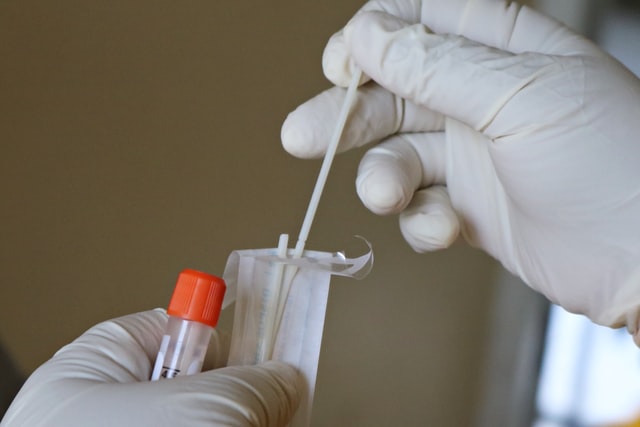NHS Test and Trace’s new position on daily contact testing as a replacement for self-isolation in secondary schools and colleges

@PHE_UK and NHS Test and Trace have released a new position on daily contact testing as a replacement for self-isolation in secondary schools and colleges.
At the end of last year the government announced a widespread testing programme in schools to detect additional asymptomatic cases and reduce transmission. This included regular testing of staff and the introduction of daily contact testing for close contacts in secondary schools. This remains an extremely important part of our overarching testing programme.
Initial pilots of testing in schools (led by Public Health England (PHE) and NHS Test and Trace), including contact testing, started in October. These pilots illustrated the potential benefit of daily contact testing in schools in detecting more positive cases and ensuring continued face-to-face education. In parallel modelling work was undertaken by SPI-M, looking at the potential for the regular testing of contacts as an alternative to self-isolation. The SAGE 68 meeting concluded that: “overall SAGE is supportive of piloting regular testing to avoid quarantine and assesses that this could provide a similar effect to the current 14-day isolation system” [note that the isolation period has subsequently reduced from 14 to 10 days].
On the basis of the potential benefit of daily contact testing in pilot schools, wider pilots and modelling work, the introduction daily contact testing was supported in schools alongside weekly testing, given the high priority of provision of education in a face-to-face setting. This is part of a wider rollout of daily contact testing, as set out in the government’s COVID-19 Winter Plan.
Since the announcement of the schools testing programme in December, we have seen the emergence of a new variant of the virus which has become dominant in the UK. The variant has been shown to have increased transmissibility and causes higher secondary attack rates. This increases the risk of transmission everywhere, including in school settings.
Given that VOC202012/01 has higher rates of transmission and hence generates a higher secondary attack rate – and that the pandemic has entered a new phase – the balance between the risks (transmission of virus in schools and onward to households and the wider community) and benefits (education in a face-to-face and safe setting) for daily contact testing is unclear.
In light of this changing situation, we now recommend that the rollout of daily contact testing within schools is paused, other than for schools involved in further evaluation. This will enable the further detailed evaluation of changing circumstances including, potentially, lower infection rates and modelling work required to understand the benefits of daily contact testing in the this new phase of the pandemic.
Schools should continue to test their staff regularly (twice-weekly where possible, in line with recommendations for other workforces that need to leave the home to work) and test pupils twice upon return to school, as has been the case since the start of January.
A government spokesperson said:
“There is no change to the main rollout of regular testing using rapid lateral flow tests in schools and colleges which is already proving beneficial in finding teachers and students with coronavirus who do not have symptoms.
“Testing is a vital part of our plan to supress this virus, and we are consistently guided by expert advice on the best way to structure the programme. Following pilots and on the advice of NHS Test and Trace, daily contact testing as a replacement to self-isolation was rolled out to keep children in school as much as possible.
“NHS Test and Trace and Public Health England have reviewed their advice, and concluded that in light of the higher prevalence and rates of transmission of the new variant, further evaluation work is required to make sure it is achieving its aim of breaking chains of transmission and reducing cases of the virus in the community.
“We are therefore pausing daily contact testing in all but a small number of secondary schools and colleges, where it will continue alongside detailed evaluation.
“Daily contact testing, used as an alternative to up to a whole class having to isolate if a positive case is detected, continues to have the potential to be a valuable tool to keep more young people and staff at school, the best place for students’ development and wellbeing. We will continue pilots to gather further data and to build the evidence base for the programme.
“Regular testing of staff will increase to twice weekly as further reassurance and to help break chains of transmission during this period.”
Further info:
- The initial pilots were conducted in schools in November and December. They illustrated the potential benefit of a daily contact testing programme in schools. For example:
- At one secondary school, daily contact testing in two separate years occurred after two separate cases were identified through NHS Test and Trace; no positive cases were identified and all children remained in school.
- In another separate event, daily contact testing commenced of close contacts of a Year 11 pupil after a positive PCR test. On the first day of testing 7 cases were identified, 6 were in the same tutor group; one additional case was identified 2 days later and the remainder of the year remained in school without further cases over the 10 day period.
- At another school, on their first screening round, cases were identified in one year group; subsequent daily testing detected further cases on day 2 and 3 of serial testing (therefore likely to have arisen prior to the daily testing) and a decision was made to isolate the year group; no additional cases were detected in others, suggesting that the daily contact testing had enabled rapid isolation.
- On the basis of the findings from the schools pilots and other modelling work, a decision was made by the government to introduce daily contact testing alongside regular testing in schools.
- Since then, a new variant VOC202012/0 has emerged and become dominant in the UK. This variant has been shown to have increased transmissibility, and there are also new more stringent national restrictions.
- As a result, the public health advice has shifted and further evaluation work is required to build the evidence base for daily contact testing given the new circumstances.
At the end of last year the government announced a widespread testing programme in schools to detect additional asymptomatic cases and reduce transmission. This included regular testing of staff and the introduction of daily contact testing for close contacts in secondary schools. This remains an extremely important part of our overarching testing programme. Initial pilots of testing in schools (led by Public Health England (PHE) and NHS Test and Trace), including contact testing, started in October. These pilots illustrated the potential benefit of daily contact testing in schools in detecting more positive cases and ensuring continued face-to-face education. In parallel modelling work was undertaken by SPI-M, looking at the potential for the regular testing of contacts as an alternative to self-isolation. The SAGE 68 meeting concluded that: “overall SAGE is supportive of piloting regular testing to avoid quarantine and assesses that this could provide a similar effect to the current 14-day isolation system” [note that the isolation period has subsequently reduced from 14 to 10 days]. On the basis of the potential benefit of daily contact testing in pilot schools, wider pilots and modelling work, the introduction daily contact testing was supported in schools alongside weekly testing, given the high priority of provision of education in a face-to-face setting. This is part of a wider rollout of daily contact testing, as set out in the government’s COVID-19 Winter Plan. Since the announcement of the schools testing programme in December, we have seen the emergence of a new variant of the virus which has become dominant in the UK. The variant has been shown to have increased transmissibility and causes higher secondary attack rates. This increases the risk of transmission everywhere, including in school settings. Given that VOC202012/01 has higher rates of transmission and hence generates a higher secondary attack rate – and that the pandemic has entered a new phase – the balance between the risks (transmission of virus in schools and onward to households and the wider community) and benefits (education in a face-to-face and safe setting) for daily contact testing is unclear. In light of this changing situation, we now recommend that the rollout of daily contact testing within schools is paused, other than for schools involved in further evaluation. This will enable the further detailed evaluation of changing circumstances including, potentially, lower infection rates and modelling work required to understand the benefits of daily contact testing in the this new phase of the pandemic. Schools should continue to test their staff regularly (twice-weekly where possible, in line with recommendations for other workforces that need to leave the home to work) and test pupils twice upon return to school, as has been the case since the start of January












Responses